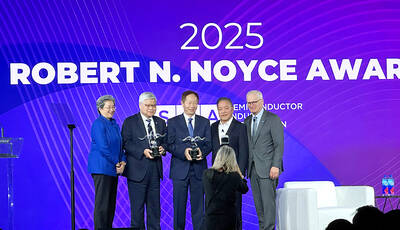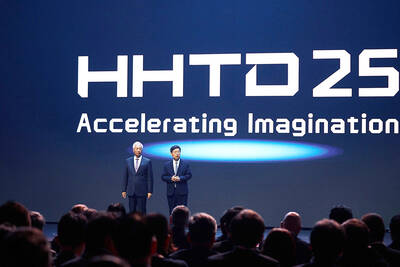David Chan, a Manchester United soccer fan in Hong Kong, says Hutchison Whampoa Ltd's (和記黃埔) new mobile-phone service doesn't let him track the team's latest goals as closely as he'd like.
"I can barely see the ball," said Chan, a 33-year-old computer engineer who downloads video clips of Manchester United games to his handset.

PHOTO: EPA
Other gripes: The phone's battery dies so quickly that he has to carry a spare, Chan said, and switching from the new video-enabled network to the more widely available older network can take more than a minute.
Hong Kong is the seventh market in Hutchison's US$22 billion bet that so-called third-generation (3G) mobile services can make money -- a strategy that hasn't paid off yet in countries such as the UK and Italy. Less than a month after introducing its "3" mobile service in Hong Kong in January, Hutchison cut prices by as much as a third to spur sales.
"It's still too soon for 3G technology," said Paul Chan, a fund manager at Invesco Asia Ltd in Hong Kong. "I'm not betting it will do better in Hong Kong than in Europe. You'd have to believe in a bit of magic."
Hong Kong-based Hutchison, headed by billionaire chairman Li Ka-shing (
The service lets users watch video clips, play games and view Web sites that are downloaded over an Internet connection seven times faster than older mobile networks offer.
Hutchison's third-generation mobile services worldwide posted a HK$3.9 billion (US$500.5 million) loss before tax and interest in the first half of last year because of fewer European subscribers than expected and startup and marketing costs.
The loss may widen to HK$12 billion for the full year and climb to HK$13 billion this year and next, said Danie Schutte, a telecom analyst at CLSA Ltd in Hong Kong.
Li said a year ago he aimed to sign up 1 million high-speed mobile users in both the UK and Italy last year. Combined users in the two markets totaled just 560,000 by year-end after technical glitches caused Motorola Inc and NEC Corp to delay shipping handsets that carry the service.
Poor video quality, difficulty connecting to other networks and short battery life -- phones lose power after about an hour of video downloads -- may deter users from the 3 service in Hong Kong, said Chay Kai Kong, an analyst at Pioneer Investments.
Arun Sarin, chief executive of Vodafone Group Plc, said on Feb. 24 that current 3G services are "unacceptable." The world's No. 1 cellular company plans to introduce the service in the second half of this year.
Services available to 3 users in Hong Kong include movie trailers, local television news and soccer match highlights with a delay of about an hour, adult photos supplied by Playboy Enterprises Inc and video conferencing.
Some users say shortcomings such as limited Internet access don't justify switching to the 3 service from existing mobile networks.
Web-connected mobile phones on existing networks -- known as 2.5G phones -- let users surf the Internet without restrictions, while Hutchison's 3G service limits users to a choice of 12 to 15 Web sites, television channels and other content providers. Users pay for each download beyond what's covered in their monthly subscription package.
"I'm locked out a lot of content because I can only get access to what Hutchison makes available," said Schutte, who subscribes to Hutchison's 3 service.
Three weeks after the 3 service's Jan. 27 debut in Hong Kong, Hutchison slashed the lowest monthly subscription rate by a third and cut the price of new handsets to less than some phones that run on rivals' slower networks. The cheapest monthly package now costs HK$183, 10 percent less than the average Hong Kong mobile-phone subscription.
"The first six months will be tough," Chay said. "To build a critical mass will take at least two years."
Japan's NTT DoCoMo Inc, which became the world's first phone company to provide 3G wireless services in October 2001, has succeeded after a slow start. Japan's biggest mobile-phone company took almost two years to sign up 1 million customers to its so-called FOMA service.
Other mobile-phone companies have delayed entering the market for high-speed services.
Deutsche Telekom AG and France Telecom SA, which led an industry-wide investment of more than US$100 billion in third-generation permits in Europe since 2000, have delayed introducing the service. Dutch carrier Royal KPN NV, the No. 3 operator in Germany, said it plans to start its 3G service there in the second half of this year.

Shiina Ito has had fewer Chinese customers at her Tokyo jewelry shop since Beijing issued a travel warning in the wake of a diplomatic spat, but she said she was not concerned. A souring of Tokyo-Beijing relations this month, following remarks by Japanese Prime Minister Sanae Takaichi about Taiwan, has fueled concerns about the impact on the ritzy boutiques, noodle joints and hotels where holidaymakers spend their cash. However, businesses in Tokyo largely shrugged off any anxiety. “Since there are fewer Chinese customers, it’s become a bit easier for Japanese shoppers to visit, so our sales haven’t really dropped,” Ito

The number of Taiwanese working in the US rose to a record high of 137,000 last year, driven largely by Taiwan Semiconductor Manufacturing Co’s (TSMC, 台積電) rapid overseas expansion, according to government data released yesterday. A total of 666,000 Taiwanese nationals were employed abroad last year, an increase of 45,000 from 2023 and the highest level since the COVID-19 pandemic, data from the Directorate-General of Budget, Accounting and Statistics (DGBAS) showed. Overseas employment had steadily increased between 2009 and 2019, peaking at 739,000, before plunging to 319,000 in 2021 amid US-China trade tensions, global supply chain shifts, reshoring by Taiwanese companies and

Taiwan Semiconductor Manufacturing Co (TSMC) Chairman C.C. Wei (魏哲家) and the company’s former chairman, Mark Liu (劉德音), both received the Robert N. Noyce Award -- the semiconductor industry’s highest honor -- in San Jose, California, on Thursday (local time). Speaking at the award event, Liu, who retired last year, expressed gratitude to his wife, his dissertation advisor at the University of California, Berkeley, his supervisors at AT&T Bell Laboratories -- where he worked on optical fiber communication systems before joining TSMC, TSMC partners, and industry colleagues. Liu said that working alongside TSMC

TECHNOLOGY DAY: The Taiwanese firm is also setting up a joint venture with Alphabet Inc on robots and plans to establish a firm in Japan to produce Model A EVs Manufacturing giant Hon Hai Precision Industry Co (鴻海精密) yesterday announced a collaboration with ChatGPT developer OpenAI to build next-generation artificial intelligence (AI) infrastructure and strengthen its local supply chain in the US to accelerate the deployment of advanced AI systems. Building such an infrastructure in the US is crucial for strengthening local supply chains and supporting the US in maintaining its leading position in the AI domain, Hon Hai said in a statement. Through the collaboration, OpenAI would share its insights into emerging hardware needs in the AI industry with Hon Hai to support the company’s design and development work, as well